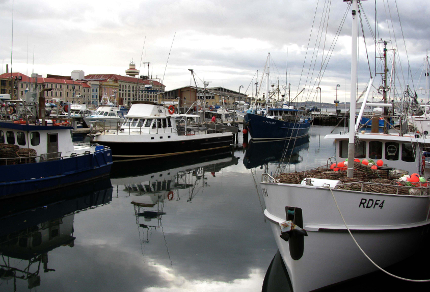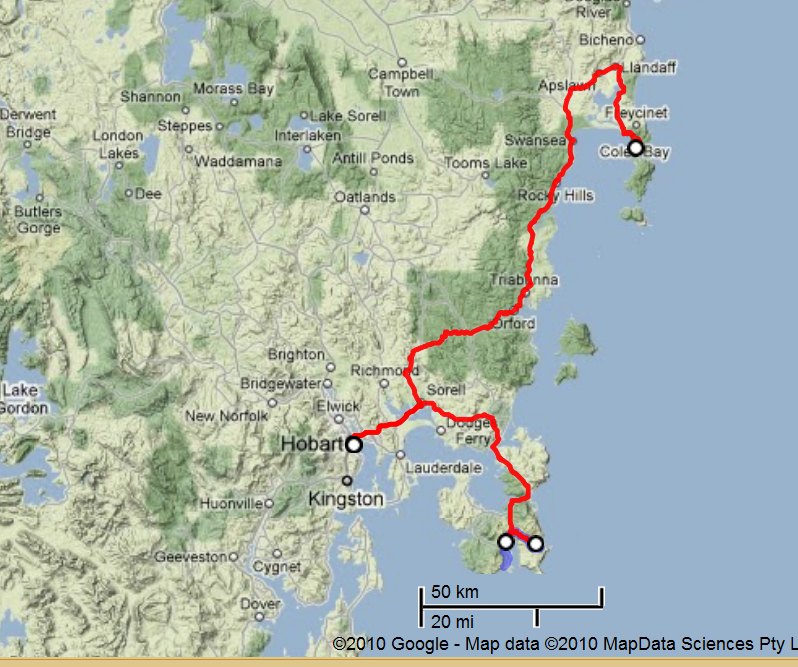
Dock in Hobart, Tasmania (© Vilis Nams)
In lifting darkness, we drove from Fortescue Bay toward Hobart, startling Tasmanian macropods into bounding quickly into vegetation alongside Tasman National Park’s gravel access road. Out on the highway, we passed quiet coves where the masts of sailboats looked like white spires of moored chapels. The tide was out, and white-faced herons, gulls, and oystercatchers foraged on the mudflats bordering the causeway across Pitt Water. As we neared Hobart, houses seemed to be pasted against hillsides edging the River Derwent. In the city, we parked near the docks and strolled to Salamanca Market, passing moored fishing and pleasure boats, as well as floating seafood and fish and chips shops.
Located on Salamanca Place, the market – about which I’d read a rave review and Vilis had heard the same at JCU – was comprised of covered pavilions and open stalls on a broad esplanade stretching for a couple of blocks adjacent to Salamanca Square. As Vilis and I strolled the crowded avenues between rows of vendors, we were struck by the market’s rich, welcoming atmosphere, rather like that of a summer fair. It exuded a refreshing charm, without any of the hawking I’d heard at the Queen Victoria Market in Melbourne. Fresh produce abounded and was reasonably priced, as were other edibles, pottery, clothing, jewellery, and woodworking and hand-crafted needlework products. We bought fresh plums and home-baked treats – rhubarb and apple coffee cake, cherry and poppyseed cheesecake – and ate weiss-wurst on chewy buns for lunch while listening to a flamenco guitarist perform live on a street corner.

Salamanca Market (© Vilis Nams)
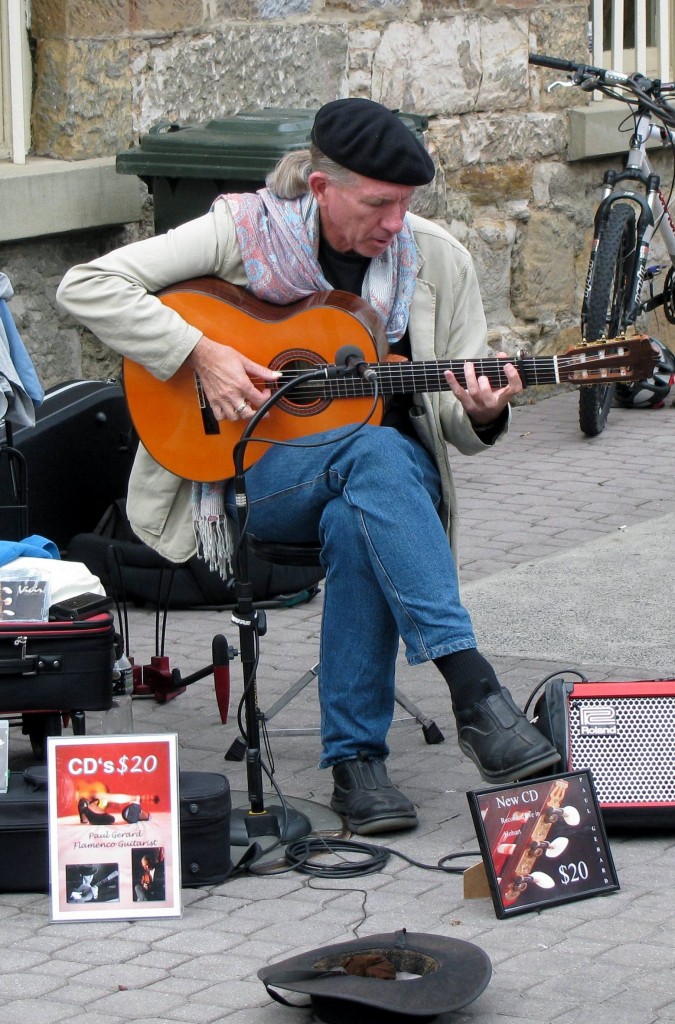
Flamenco Guitarist at Salamanca Market (© Vilis Nams)
Buskers were everywhere, with a harpist and drummer in a grassy park adjacent to the market and other performers on street corners and in Salamanca Square – a pop/folk trio, a female vocalist with guitar accompaniment, a jazz duet, a South American band with pan flute, and my favourite, a young male opera singer belting out his best in a red t-shirt.
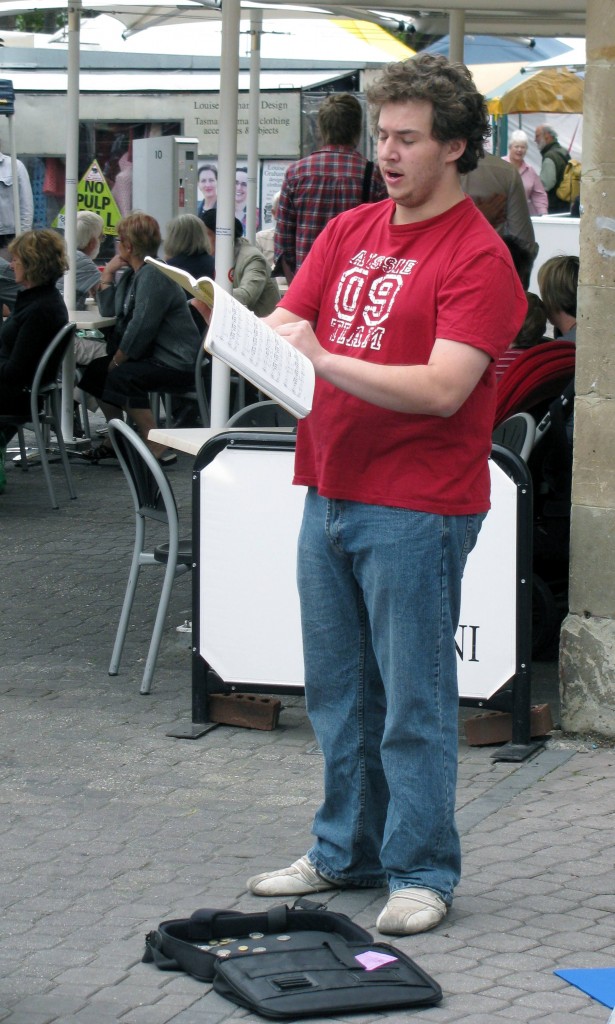
Opera Singer at Salamanca Market (© Vilis Nams)
We tossed our dirty laundry into a wash machine in a laundrette/café in Salamanca Square, then strolled the market some more and sat near a fountain, watching toddlers drawn to the water like moths to a flame and simply soaking up the refreshingly real, down-to-earth atmosphere of Hobart.

Young Juggler in Salamanca Square (© Vilis Nams)
In early afternoon, satiated with Salamanca Market, we headed east from Hobart to Sorell, and then north toward the east coast’s Freycinet Peninsula and its national park. The A3 led us through a narrow plain bordered by tawny hills scattered with eucalypts, gorse, and shrubs. Sheep and horses grazed in small paddocks on the plain, which gave way to rolling, forested hills, and then to rangeland grazed by large flocks of sheep that appeared as grey tufts in the bleached, golden pastures.
The Alto struggled up steep, twisting climbs into coastal hills that were wilder than we expected. The hills gave way to another narrow plain, this one supporting plantations of blue-green eucalypts. Near Orford, resorts, cabins for rent, and pleasure boats moored in the river exuded the flavour of cottage country. The seaside plain at Triabunna was backed by wooded hills, and beyond the town, we moved onto an inland plain as we traveled northward. Past Swansea, again near the coast, we encountered ploughed fields, vineyards, a walnut orchard and olive grove, as well as more sheep. We continued northeast, skirting Moulting Bay Lagoon, a vast wetland used as a staging ground by waterfowl,1 and then turned south onto Freycinet Peninsula.
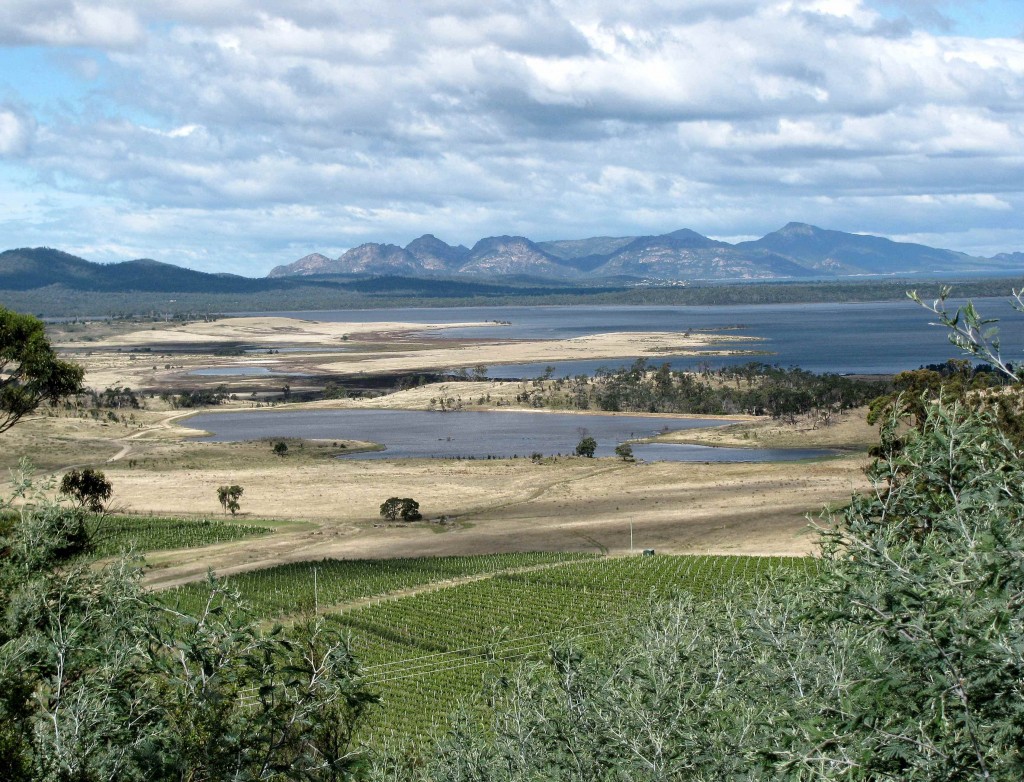
Vineyards, Moulting Bay Lagoon, and The Hazards Peaks (© Magi Nams)
The access road to the Richardson’s Bay campground in Freycinet National Park was no narrow gravel road like the one we drove to the Fortescue Bay campground in Tasman National Park; instead, it was a smooth, paved highway. I suggested to Vilis that its beautifully maintained surface might have something to do with the fact that the Freycinet Peninsula is, according to The Rough Guide to Tasmania, the state’s favourite ocean playground.2 The national park hosts 20,000 visitors a year, the bulk of those during the January school break.3 The guide also described the park as “wilderness with amenities”4 and no shortage of ways to spend money on “lamping,” which translates as luxury camping. 5
At one point on the drive into the park, Vilis almost screeched to a halt, having spotted an intriquing shape in a field beside the highway. The shape revealed itself as an emu, one of two in a field of golden grasses below a house on a hill. Although emus are native Australian birds that once occupied Tasmania, the Tassie population became extinct during the 19th century as a result of settlement and overhunting by European colonists.6 The birds we saw were likely introduced from the mainland, where emus still occur throughout much of the continent.

Mystery Shape (© Vilis Nams)

Emu (© Vilis Nams)
We set up camp at Richardson’s Bay under hot late afternoon sun, with grey fantails, thornbills, and a superb fairy wren singing and flitting within surrounding shrubs and bracken ferns.
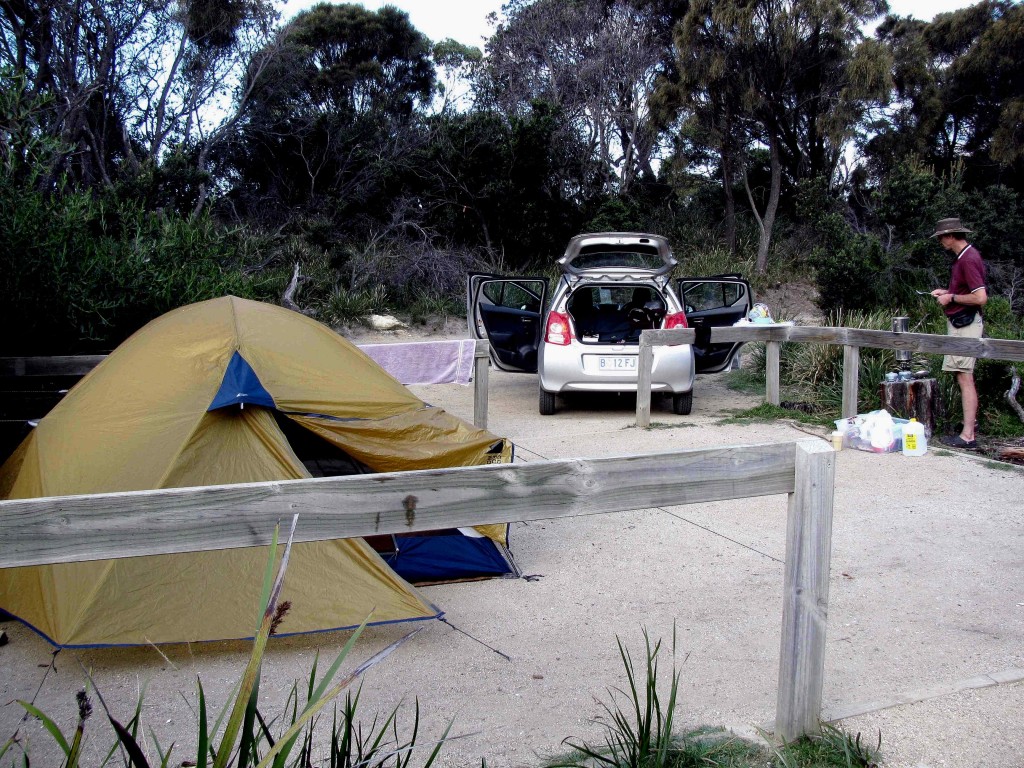
Vilis Cooking Supper at Richardson’s Beach Camp, Freycinet National Park (© Magi Nams)
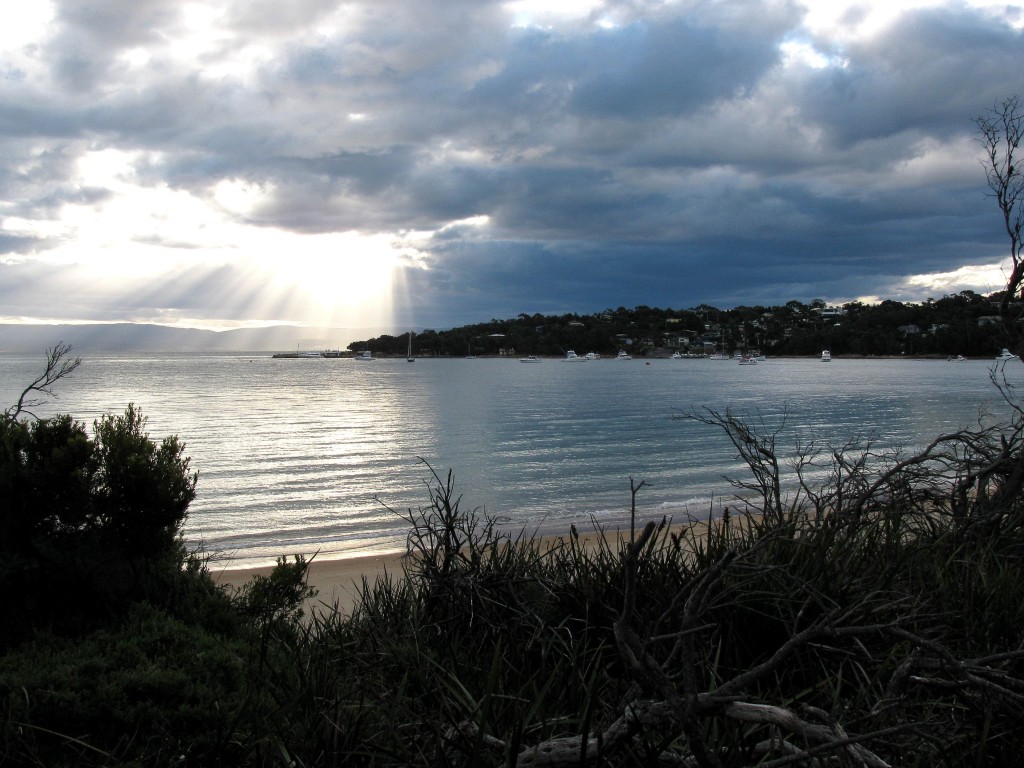
Richardson’s Beach, with Cole’s Bay in Background (© Vilis Nams)
After supper, we strolled Richardson’s Beach below our campsite, and when darkness fell, went hunting for Tasmanian wildlife by driving slowly along the roads within the park, hoping to catch eye shine of mammals and spot them in the beams from the car’s headlights. In particular, we looked for Tasmanian devils – stocky, black with white markings, big head, not bounding – but what we saw was a total of 5 common brushtail possums and 5 eastern quolls. The latter are small, lively carnivores with white spots on their backs. The possums just looked at us, dazed by the lights, but the quolls, which were a fawn colour, except for one that was black, romped along the roads for a bit, giving us a good view of their rat-like faces and long, unmarked tails. With those cute spots, they looked totally unlike any other carnivore I’d ever seen, but then, we were in Tasmania.
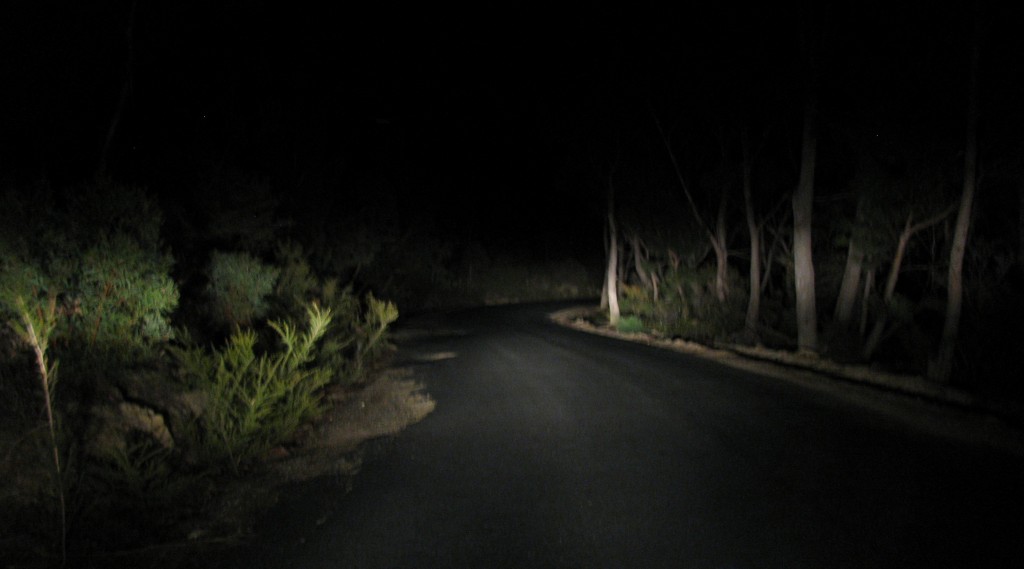
Searching for Nocturnal Wildlife (© Magi Nams)
Today’s fauna: silver gulls, Pacific gulls, grey fantails, superb fairy-wren, Tasmanian thornbills, *little wattlebird, red-necked wallabies, common brushtail possums, *eastern quolls. (* lifelist sighting)
References:
1. James Stewart and Margo Daly. The Rough Guide to Tasmania. 2008. Rough Guides, New York. p. 190; 2. Ibid, p. 191; 3. Ibid, p. 186; 4. Ibid, p. 188; 5. Ibid, p. 191.
6. Graham Pizzy and Frank Knight. The Field Guide to the Birds of Australia. 1997. Angus & Robertson, Sydney. p. 18.

